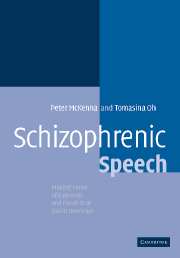Book contents
- Frontmatter
- Contents
- Preface
- 1 Describing schizophrenic speech
- 2 Thought disorder as a syndrome in schizophrenia
- 3 The differential diagnosis of thought disorder
- 4 Thought disorder as a form of dysphasia
- 5 Thought disorder and communicative competence
- 6 Thought disorder as a dysexecutive phenomenon
- 7 The dyssemantic hypothesis of thought disorder
- 8 Some conclusions and a few speculations
- References
- Index
3 - The differential diagnosis of thought disorder
Published online by Cambridge University Press: 19 August 2009
- Frontmatter
- Contents
- Preface
- 1 Describing schizophrenic speech
- 2 Thought disorder as a syndrome in schizophrenia
- 3 The differential diagnosis of thought disorder
- 4 Thought disorder as a form of dysphasia
- 5 Thought disorder and communicative competence
- 6 Thought disorder as a dysexecutive phenomenon
- 7 The dyssemantic hypothesis of thought disorder
- 8 Some conclusions and a few speculations
- References
- Index
Summary
At times, thought disorder has been considered to be a symptom of, and only of, schizophrenia. Nowhere was this more true than in American psychiatry, which until comparatively recently laboured under Bleuler's (1911) dictate that it was one of the fundamental symptoms of schizophrenia. Harrow and Quinlan (1977), for example, noting that countless authors since Bleuler had ‘affirmed its importance as a central feature of this disorder’, stated that ‘some astute clinicians have believed that reliance on disordered thinking is a certain way to distinguish schizophrenics from non-schizophrenics’. This view persisted until their own and others' studies (e.g. Harrow et al., 1973; Harrow and Quinlan, 1977; Carlson and Goodwin, 1973; Taylor and Abrams, 1975) began to cast doubt on its universality in the disorder. These studies also made it clear, to nobody's surprise but their authors', that thought disorder was seen in at least one other disorder, mania.
This point was also made by Andreasen, in a typically pragmatic way, in one of her earliest studes (Andreasen et al., 1974). She showed a group of forty-two psychiatrists, psychologists and social workers at the hospital where she worked six samples of prose and asked them to decide whether thought disorder was present and what diagnosis they suspected in each case. Two of the samples were from patients with schizophrenia, two from patients with mania, and the remaining two consisted of an extract from James Joyce's Finnegans Wake and part of a poem retyped in prose form, The Perfection of Dentistry by Marvin Bell.
- Type
- Chapter
- Information
- Schizophrenic SpeechMaking Sense of Bathroots and Ponds that Fall in Doorways, pp. 48 - 79Publisher: Cambridge University PressPrint publication year: 2005



